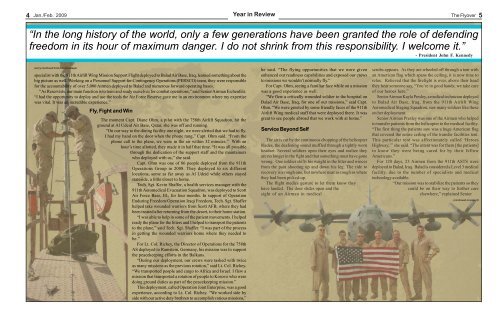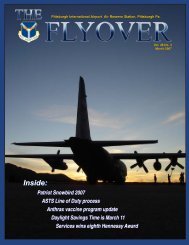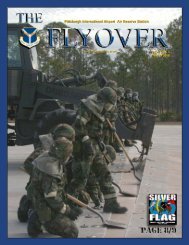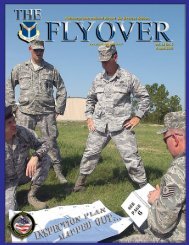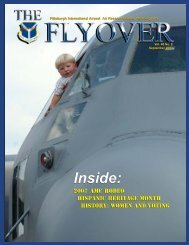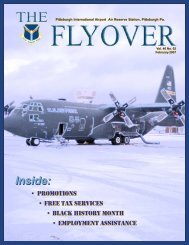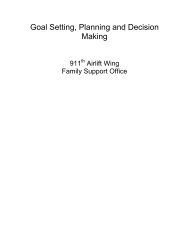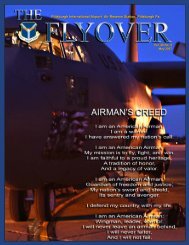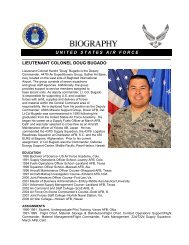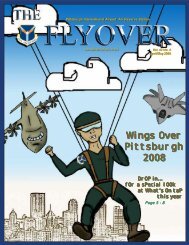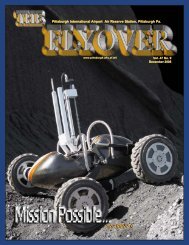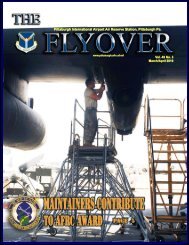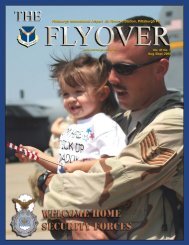January/February - Pittsburgh IAP Air Reserve Station
January/February - Pittsburgh IAP Air Reserve Station
January/February - Pittsburgh IAP Air Reserve Station
You also want an ePaper? Increase the reach of your titles
YUMPU automatically turns print PDFs into web optimized ePapers that Google loves.
Year in Review<br />
4 Jan./Feb. 2009 The Flyover 5<br />
“In the long history of the world, only a few generations have been granted the role of defending<br />
freedom in its hour of maximum danger. I do not shrink from this responsibility. I welcome it.”<br />
- President John F. Kennedy<br />
(story continued from previous page)<br />
specialist with the 911th <strong>Air</strong>lift Wing Mission Support Flight deployed to Balad <strong>Air</strong> Base, Iraq, learned something about the<br />
big picture as well. Working on a Personnel Support for Contingency Operations (PERSCO) team, they were responsible<br />
for the accountability of over 5,000 <strong>Air</strong>men deployed to Balad and numerous forward operating bases.<br />
“As Reservists, our main function is to train and ready ourselves for combat operations,” said Senior <strong>Air</strong>man Eichenfels.<br />
“I had the opportunity to deploy and use the tools the <strong>Air</strong> Force <strong>Reserve</strong> gave me in an environment where my expertise<br />
was vital. It was an incredible experience.”<br />
Fly, Fight and Win<br />
The moment Capt. Diane Ohm, a pilot with the 758th <strong>Air</strong>lift Squadron, hit the<br />
ground at Al Udeid <strong>Air</strong> Base, Qatar, she was off and running.<br />
“On our way to the dining facility one night, we were alerted that we had to fly.<br />
I had my hand on the door when the phone rang,” Capt. Ohm said. “From the<br />
phone call to the plane, we were in the air within 32 minutes.” With an<br />
hour’s time allotted, they made it in half that time. “It was all possible<br />
through the dedication of the support staff and the maintainers<br />
who deployed with us,” she said.<br />
Capt. Ohm was one of 86 people deployed from the 911th<br />
Operations Group in 2008. They deployed to six different<br />
locations, some as far away as Al Udeid while others stayed<br />
stateside, a little closer to home.<br />
Tech. Sgt. Kevin Shaffer, a health services manager with the<br />
911th Aeromedical Evacuation Squadron, was deployed to Scott<br />
<strong>Air</strong> Force Base, Ill., for four months. In support of Operation<br />
Enduring Freedom/Operation Iraqi Freedom, Tech. Sgt. Shaffer<br />
helped take wounded warriors from Scott AFB, where they had<br />
been treated after returning from the desert, to their home station.<br />
“I was able to help in some of the patient movements. I helped<br />
ready the plane for the litters and I helped to transport the patients<br />
to the plane,” said Tech. Sgt. Shaffer. “I was part of the process<br />
in getting the wounded warriors home where they needed to<br />
be.”<br />
For Lt. Col. Richey, the Director of Operations for the 758th<br />
AS deployed to Ramstein, Germany, his mission was to support<br />
the peacekeeping efforts in the Balkans.<br />
“During our deployment, our crews were tasked with twice<br />
as many missions as the previous rotation,” said Lt. Col. Richey.<br />
“We transported people and cargo to Africa and Israel. I flew a<br />
mission that transported a rotation of people to Kosovo who were<br />
doing ground duties as part of the peacekeeping mission.”<br />
This deployment, called Operation Joint Enterprise, was a good<br />
experience, according to Lt. Col. Richey. “We worked side by<br />
side with our active duty brethren to accomplish various missions,”<br />
he said. “The flying opportunities that we were given<br />
enhanced our readiness capabilities and exposed our crews<br />
to missions we wouldn’t normally fly.”<br />
For Capt. Ohm, seeing a familiar face while on a mission<br />
was a good experience as well.<br />
“We flew a critically wounded soldier to the hospital on<br />
Balad <strong>Air</strong> Base, Iraq, for one of our missions,” said Capt.<br />
Ohm. “We were greeted by some friendly faces of the 911th<br />
<strong>Air</strong>lift Wing medical staff that were deployed there. It was<br />
great to see people abroad that we work with at home.”<br />
Service Beyond Self<br />
The air is cut by the continuous chopping of the helicopter<br />
blades, the deafening sound muffled through a tightly worn<br />
headset. Several soldiers open their eyes and realize they<br />
are no longer in the fight and that something must have gone<br />
wrong. One soldier shifts his weight in the litter and winces<br />
from the pain shooting up and down his leg. The ride to<br />
recovery is a rough one, but nowhere near as rough as where<br />
they had been picked-up.<br />
The flight medics gesture to let them know they<br />
have landed. The door slides open and the<br />
sight of an <strong>Air</strong>man in medical<br />
scrubs appears. As they are wheeled off through a tent with<br />
an American flag which spans the ceiling, it is now time to<br />
relax. Relieved that the firefight is over, above their head<br />
they hear someone say, “You’re in good hands; we take care<br />
of our heroes here.”<br />
Senior <strong>Air</strong>man Kayla Presley, a medical technician deployed<br />
to Balad <strong>Air</strong> Base, Iraq, from the 911th <strong>Air</strong>lift Wing<br />
Aeromedical Staging Squadron, saw many soldiers like these<br />
on her deployment.<br />
Senior <strong>Air</strong>man Presley was one of the <strong>Air</strong>men who helped<br />
to transfer patients from the helicopter to the medical facility.<br />
“The first thing the patients saw was a huge American flag<br />
that covered the entire ceiling of the transfer facilities tent.<br />
This particular tent was affectionately called ‘Heroes<br />
Highway,’” she said. “The intent was for them [the patients]<br />
to know they were being cared for by their fellow<br />
Americans.”<br />
For 120 days, 23 <strong>Air</strong>men from the 911th ASTS were<br />
deployed to Balad, Iraq. Balad is considered a Level 3 medical<br />
facility, due to the number of specialists and medical<br />
technology available.<br />
“Our mission was to stabilize the patients so they<br />
could be on their way to further care<br />
elsewhere,” explained Senior<br />
(continued on page 8)


